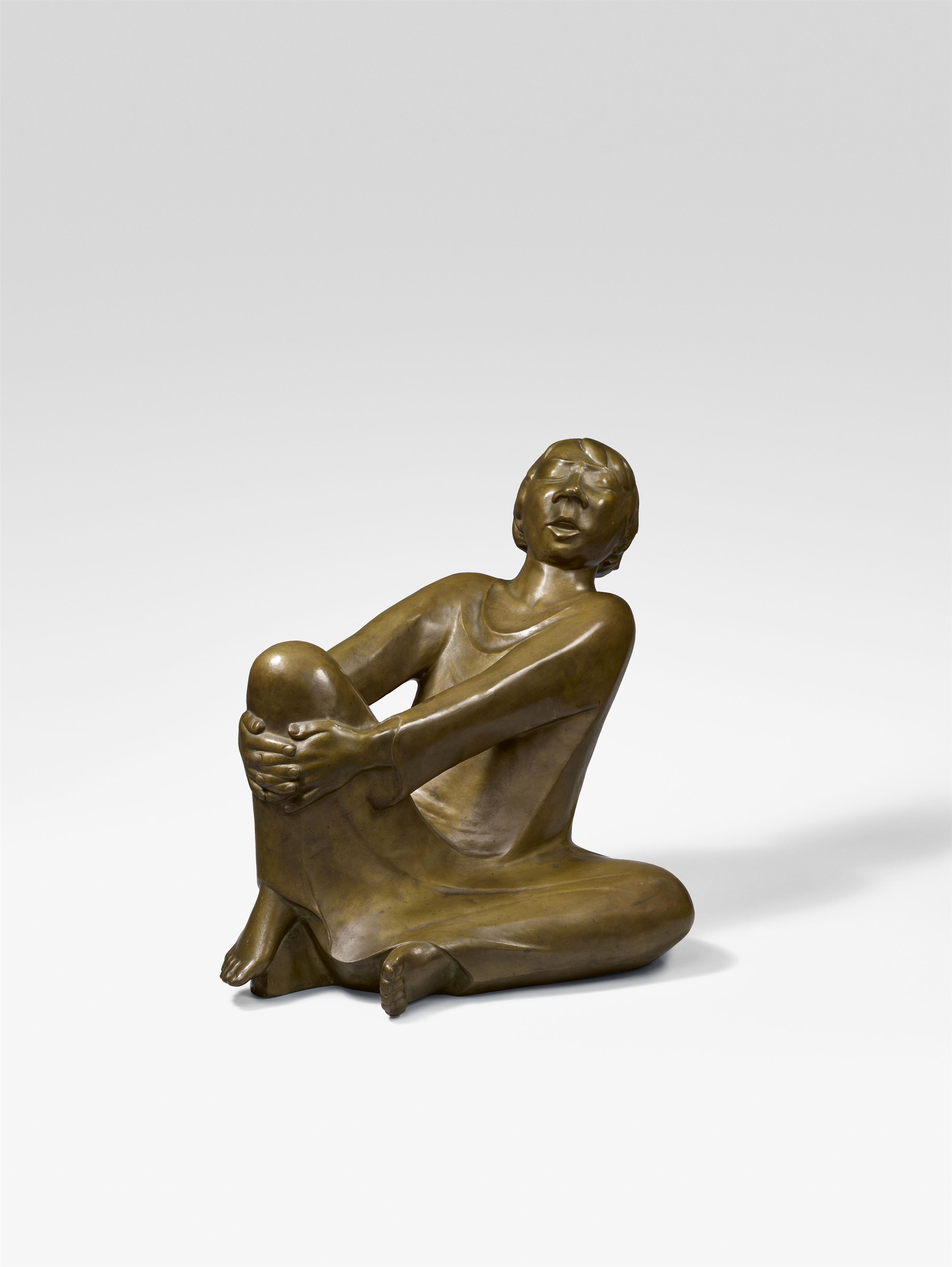Ernst Barlach
Der Singende Mann
1928
Bronze sculpture. Height 49.5 cm. Signed 'E. Barlach' and with foundry mark "H. NOACK BERLIN" on lower side of footrest and cloak hem. From a total edition of 57 casts mentioned by Laur, of which approx. 16 early life-time casts from the edition by Galerie Flechtheim. Posthumous cast.
The magnificent figure “Der Singende Mann” is surely Ernst Barlach’s most famous work of sculpture. The fervently singing young man holds his right knee in his locked hands while his bent left leg rests on the ground. This produces a triangular composition extending into space, and his gesture of leaning back with his eyes closed underscores the bronze’s simultaneously expressive and contemplative character. With this relaxed pose and cheerful, untroubled facial expression, it stands in contrast to the otherwise more serious and statuesque effect of the sculptor’s works.
Berthold Brecht, a keen observer of his time, described the realistic and human quality of the “Singender Mann” in 1952 in the notes he wrote about a Barlach exhibition in West Berlin: “The singing man, a bronze of 1928, sings boldly, in a free pose, clearly working on his singing. He sings alone but seems to have listeners. Barlach’s humour wishes him to be a little vain, but not more so than is compatible with the practice of art.” (cited in: Der Bildhauer Ernst Barlach. Skulpturen und Plastiken im Ernst Barlach Haus – Stiftung Hermann F. Reemtsma, Hamburg 2007, p. 159).
Following the death of Barlach’s gallerist Paul Cassirer in 1926, Alfred Flechtheim became responsible for his sculptural work. He encouraged the artist, who had completely concentrated on the material of wood up to that point, to use bronze more often in realising his sculptures. Thus, following the 1927 monument in Güstrow, the “Singender Mann” would be among the first sculptures that Barlach conceived with a full sense of conviction in what was a new material for him. This also explains the sculpture’s great popularity: the edition released by Flechtheim sold out shortly after it was released, a new edition was produced after the war and, today, this work is among the most sought-after German Expressionist sculptures.
Catalogue Raisonné
Laur 432; Schult I 343
Provenance
Probably acquired from Roman Norbert Ketterer, Campione d'Italia (1972); Collection Wilhelm Reinold, Hamburg; thenceforth family property, Rhineland
Literature
I.a. Alfred H. Barr, Omnibus, German Sculpture, Berlin/Düsseldorf 1932, p. 38-42; Marguerite Devigne, Ernst Barlach, in: Les Beaux-Arts, Brüssel 1935, p. 14; Carl Dietrich Carls, Ernst Barlach, Das plastische, graphische und dichterische Werk, 5th ed., Flensburg/Hamburg 1950, p. 58; Paul Fechter, Ernst Barlach, Gütersloh 1957, p. 35; Franz Fühmann (ed.), Ernst Barlach, Das Wirkliche und Wahrhaftige, Wiesbaden 1970, p. 159; Kunstblätter der Galerie Nierendorf, Ernst Barlach. Plastik, Zeichnungen, Graphik, 13.9.-5.12.1978, Berlin, September 1978, cat. no. 41 with illus. no. 21 ; Anita Beloubek-Hammer, Ernst Barlach, Plastische Meisterwerke, Leipzig 1996, p. 116 f.; Helga Thieme, Ernst Barlachs Skulptur "Der singende Mann" in der Ausstellung "Neue deutsche Kunst", Oslo 1932, in: exhib. cat. Rostock 1998, p. 310 ff.
Exhibitions
I.a. Berlin/Düsseldorf 1930 (Galerie Alfred Flechtheim), November/Dezember, cat. no. 19; New York 1931 (Museum of Modern Art), Art in Our Time; Berlin 1951/1952 (Deutsche Akademie der Künste), Ernst Barlach, cat. no 34, p. 13 with illus.
According to Laur, casts are located in the following museum collections: Neue Nationalgalerie, Berlin; The Cleveland Museum of Art, Cleveland/Ohio, USA; Lyman Allyn Museum, New London/Connecticut, USA; Museum of Modern Art, New York, USA; Germanisches Nationalmuseum, Nuremberg; Schloss Gottorf, Schleswig; Staatliches Museum Schwerin; Ernst Barlach Stiftung, Güstrow; Hamburger Kunsthalle; Von der Heydt-Museum, Wuppertal

